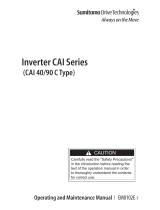
Start-up Commissioning the drive
S.1 Quick installation and commissioning flowchart ................................................................................... S - 2
S.2 Instructing in using the panel.................................................................................................................. S - 3
S.3 Example of I/O connections ................................................................................................................... S - 4
S.4 Basic Parameter Setting to Drive Motor ................................................................................................. S - 8
S.4.1 Setting Frequency command source and Run command source .............................................. S - 8
S.4.2 Frequency command source selection ..................................................................................... S - 9
S.4.3 Run command source selection ............................................................................................... S - 11
S.5 Selecting the control mode ..................................................................................................................... S - 13
Chapter 1 Overview
1.1 Inspection of the Purchased Product ············································································· 1 - 2
1.1.1 Inspecting the product·················································································· 1 - 2
1.1.2 Quick Reference Guide and Instruction Manual···················································· 1 - 2
1.2 Method of Inquiry and Product Warranty ······································································· 1 - 3
1.2.1 Method of inquiry ······················································································ 1 - 3
1.2.2 Product warranty ························································································ 1 - 3
1.2.3 Warranty Terms ························································································· 1 - 3
1.3 Exterior Views and Names of Parts ·············································································· 1 - 4
Chapter 2 Installation and Wiring
2.1 Installation ·········································································································· 2 - 2
2.1.1 Precautions for installation ············································································ 2 - 3
2.1.2 Backing plate ···························································································· 2 - 5
2.2 Wiring ··············································································································· 2 - 6
2.2.1 Terminal connection diagram and explanation of terminals and switch settings ··············· 2 - 7
2.2.2 Wiring of the main circuit ············································································· 2 - 10
2.2.3 Wiring of the control circuit ··········································································· 2 - 19
2.2.4 Wiring of the digital operator ········································································· 2 - 20
Chapter 3 Operation
3.1 Operating Methods ································································································· 3 - 2
3.2 How to operate the Digital Operator (OPE-SBK) ····························································· 3 - 4
3.2.1 Names and functions of components ······························································· 3 - 4
3.2.2 Code display system and key operations ···························································· 3 - 5
Chapter 4 List of Data Settings
4.1 Precautions for Data Setting ······················································································ 4 - 2
4.2 Monitoring Mode ·································································································· 4 - 2
4.3 Function Mode ····································································································· 4 - 3
4.4 Extended Function Mode ························································································· 4 - 4
Chapter 5 Error Codes
5.1 Error Codes and Troubleshooting ················································································ 5 - 2
5.1.1 Error codes ······························································································ 5 - 2
5.1.2 Trip conditions monitoring ············································································ 5 - 4
5.2 Warning Codes ····································································································· 5 - 5
Chapter 6 Specifications
6.1 Specifications ······································································································· 6 - 2
6.2 External dimensions ······························································································· 6 - 5






















